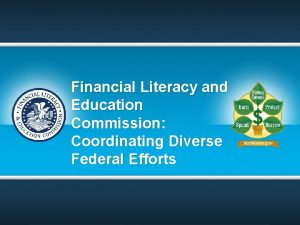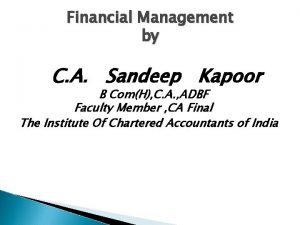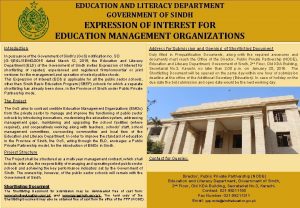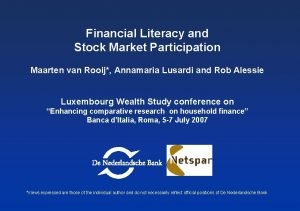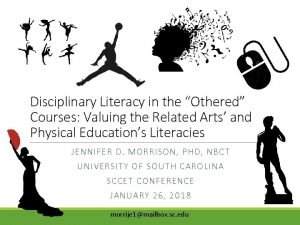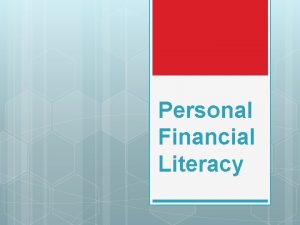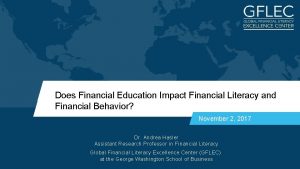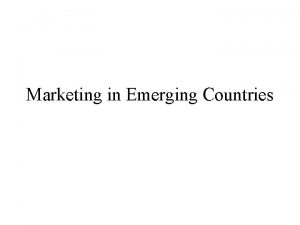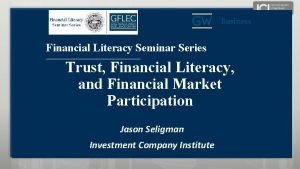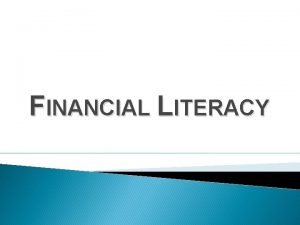Financial Education and Financial Literacy Emerging Insights Ruchika













- Slides: 13

Financial Education and Financial Literacy: Emerging Insights Ruchika Singh, Senior Policy Manager and Finance Sector Lead, J-PAL South Asia 9 November, 2017

J-PAL’s mission is to reduce poverty by ensuring that policy is informed by scientific evidence. What we do J-PAL conducts randomized evaluations to test and improve the effectiveness of poverty reduction programmes across sectors. Agriculture Crime Education Environment and Energy Who we are Network of 154 professors from over 49 universities… Health Finance and Microfinance Labour Markets Political Economy & Governance Where we work Headquartered at MIT, 7 regional offices and research in 80 countries

J-PAL’s finance sector • Measure the impact of financial services, products, and process innovations • Understand how access to financial services can be used as a mechanism to reduce poverty and spur economic development Financial products Microcredit Remittances Savings Insurance 861 evaluations, 8 sectors, 80 countries Finance sector, 248 evaluations, 53 countries Financial Inclusion Social protection Financial education & literacy Mobile money Islamic finance Universal basic income Graduation programmes

Why do we care about financial education & literacy? Low financial literacy is a major barrier to financial inclusion • 76% of Indians are not financially literate (do not understand concepts of risk diversification, interest and inflation) Question to policymakers: What is most effective policy to improve financial access for the poor? Better laws, New lending, [VALUE] Financial education, [VALUE] Others, [VALUE] Policymakers link financial literacy and capability to financial education Theory of Change Lack of understanding or use financial products incorrectly People participate in lessons Effective financial education delivered Financial education lessons applied in practice World Bank, 2014 (poll), The Standard & Poor’s Ratings Services Global Financial Literacy Survey 2014 Better financial health and growth

Challenges of financial education programmes Lack of understanding or use financial products incorrectly 1 People participate in lessons Low take-up is often an issue, even with incentives Effective financial education delivered Financial education lessons applied in practice Better financial health and growth 2 • Limited evidence of knowledge translating to action o Meta-analysis of studies find limited downstream impacts of financial education Based on studies in Mexico, Qatar, and Dominican Republic • Challenge of isolating impact of training on outcomes o Randomized evaluations allow us to measure true impact of financial education Based on studies in Dominican Republic, India, Indonesia, and Philippines Miller et al. , 2014 (overview)

Addressing low take-up Lack of understanding or use financial products incorrectly Country Mexico • • People participate in lessons Training Financial education lessons applied in practice Effective financial education delivered Better financial health and growth Incentive Attendance rate Target Population Free transport 25% $72 gift card 39% All adults in Mexico City, recruited online, via mail, and in-person surveys on busy streets and in line at the partner financial institution 4 -hour session Qatar 3 -hour session Dinner 41% Indian migrant workers and their wives Dominican Republic 5 -6 weekly 3 -hour sessions (none) 44% Existing creditors of the partner financial institution Benefits of financial education can be perceived as low Policymakers need to think about take-up of lessons, incentives and targeting and communicating the benefits of financial education Bruhn et al. , 2013 (Mexico); Seshan and Yang, 2012 (Qatar); Drexler et al. , 2010 (Dominican Republic)

Designing effective financial education Lack of understanding or use financial products incorrectly People participate in lessons Effective financial education delivered Financial education lessons applied in practice Better financial health and growth Dominican Republic: Entrepreneurs who received simple rules of thumb (Financial Heuristics) training vs a standard accounting training were more likely to improve business practices and performance Details: • Savings and credit bank clients with small businesses were offered two types of financial training programs with different approaches: • 6 week standard accounting training or 5 weeks rules of thumb training Results: • Clients receiving rule-of-thumb training: • More likely to separate their accounts, calculate revenue formally, and keep account records • Improved business outcomes, and average sales increased, especially during bad weeks • Reduce complexity of trainings like sharing simple, easy to recall yet sound business practices Drexler et al. , 2010

Designing effective financial education Lack of understanding or use financial products incorrectly People participate in lessons Effective financial education delivered Financial education lessons applied in practice Better financial health and growth India and Philippines: Using mobile phones as a delivery channel for scaling up of rules of thumb based training Details: • For testing a cheap and scalable ‘rules of thumb’ based training approach: • Develop and test the effectiveness of a mobile-phone based technology (weekly voice-based messages with follow-up reminder messages)to provide rules of thumb training to micro entrepreneurs in India (Completed) • Results: Mobile phone an effective delivery channel for rules of thumb based training • Adapt content from India for Philippines and design scale-up version for both India and Philippines (Ongoing) • Results: Expected in December 2017 • Policymakers need to think about feasibility of scaling up effective programmes Cole and Schoar (ongoing)

Designing effective financial education Lack of understanding or use financial products incorrectly People participate in lessons Effective financial education delivered Financial education lessons applied in practice Better financial health and growth Indonesia: Targeted, actionable & accessible training for overseas migrant workers increases financial knowledge Details: • Indonesian overseas migrant workers and their families trained on financial planning, sending/receiving remittances and understanding migrant insurance • Measured the relative efficacy of delivering training only to migrant worker, only to main remittance receiver, or both Results: • When the worker alone or the remittance receiver were trained, financial knowledge increased; but knowledge increase was greatest when both were trained together • Greater financial planning, budgeting, and saving when both the worker and the family member were trained • Policymakers need to think about making trainings timely, targeted, actionable and accessible Doi et. al (Indonesia)

Designing effective financial education Lack of understanding or use financial products incorrectly People participate in lessons Effective financial education delivered Financial education lessons applied in practice Better financial health and growth India: Personalized add-ons to a financial education course positively affect financial behaviors Details: • Five weeks of financial literacy training consisting of a five-week video series covering budgeting, savings, loans, and insurance along with personalized add-ons like financial counseling and goalsetting Results: • Financial education videos alone increased awareness of financial products, but not behaviors • Bundling training with personalized add-ons, like goal-setting and counseling leads to impact on both financial knowledge and behaviors • • • People face multiple constraints in improving financial behaviour Simple strategies to overcome behavioural barriers such as procrastination and forgetfulness can result in increased impact Policymakers need to think about making trainings personalised and actionable Carpena et al. , 2010 (India)

Conclusion • Initial low take-up is often an issue, with limited subsequent impact on financial behaviours • Difficult to translate knowledge to action • Trainings that are simple, targeted, actionable, and/or accessible are more likely to be effective • Practitioners, policymakers and researchers need to work together to better understand how to improve take-up and design, test and pilot effective programmes Open questions • What strategies can be used to ensure that improvements in knowledge are applied to real-world financial decisions? • Which financial education strategies are most cost-effective? How do you compare cost-effectiveness of different financial education and literacy programs? • How do you deal with the challenges of scaling up effective programs? Are digital solutions are the way to go?

Thank you Ruchika Singh rsingh@povertyactionlab. org

Learn more www. povertyactionlab. org/finance www. poverty-action. org/program-area/financial-inclusion 12
 Osu
Osu Dr ruchika husa
Dr ruchika husa Financial literacy and education commission
Financial literacy and education commission Similarities of media literacy and technology literacy
Similarities of media literacy and technology literacy Media technology and information literacy venn diagram
Media technology and information literacy venn diagram Different dimensions of people media
Different dimensions of people media Cyber literacy for the digital age
Cyber literacy for the digital age Emerging role of finance manager in india
Emerging role of finance manager in india Sindh education and literacy department
Sindh education and literacy department How formal education differ from als
How formal education differ from als Education and literacy department
Education and literacy department Financial literacy and stock market participation
Financial literacy and stock market participation Disciplinary literacy in physical education
Disciplinary literacy in physical education Bhartiya model of financial literacy
Bhartiya model of financial literacy


